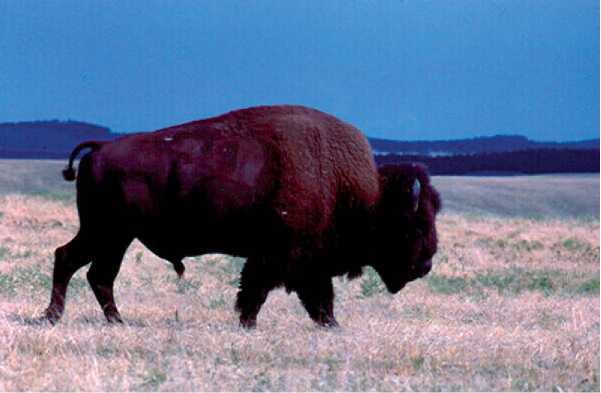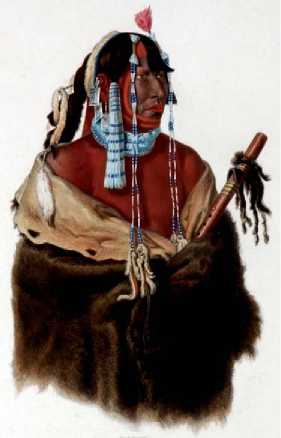Nomadic bison hunters continued to live on the High Plains in the west throughout prehistory, though the bison they were hunting after about 8000 BC were now of modern size (see Figure 8). Though we have little information on these people in late prehistoric times, their way of life was a very ancient one, and persisted with remarkably little change from Archaic

Figure 8 The American bison. Photograph by W. Raymond Wood.
Times until the historic arrival of guns and the Old World horse. Things were to change dramatically with the arrival of these two elements. Native North American horses had become extinct after Clovis times, but their re-introduction by the Spanish in the southwest soon led to their diffusion north into the Great Plains and thence west into the Columbia River area by the early 1700s. Horses meant that burdens could be pulled more easily than by the dogs previously used, and hunters could range over vastly greater areas in search of game.
The introduction of guns by French traders furthered this revolution in hunting and in warfare. Because the Spanish in the American southwest prohibited the sale of guns to Indians, Native American markets on the plains - especially in the north - saw a brisk trade as the guns obtained from French traders to the northeast were traded for horses that originated in the Spanish settlements. Plains Indians now had great mobility and the ability to kill game and enemies at heretofore impossible distances. This led to the historic stereotype of the mounted Indian warrior. These new elements radiated throughout the plains, leading to such diverse changes as larger tipis, and the ability of a man to have multiple wives. Profits made by such middlemen traders as the Mandans made them extremely wealthy.
By historic times there was a plains-wide trading system, interwoven with relations with far-flung groups that, indeed, formed a pan-continental trading network. In the plains this trade was fostered by the famous plains sign language, a pidgin that permitted easy communication between groups who spoke radically different languages. Trade was also facilitated by the Calumet Ceremony, which involved the ‘adoption’ of individuals across tribal boundaries, and placed trade in a social setting that was familiar and comfortable to both parties. Exchanges between the gardening tribes and the nomadic hunters and gatherers was one of the mechanisms that led to such striking similarities between the tools and weapons of these two groups who were, on the face of matters, so distinctive in their way of life.
Another effect of white contact was the precipitous decline in population that resulted from the introduction of several diseases that were previously unknown in North America and to which they had no immunity. The principal killer was smallpox, as it often led to the deaths of more than 90% of its Indian victims. The number of deaths from smallpox, measles, mumps, whooping cough, and other diseases across the plains cannot be calculated, but between about 1750 and 1837 the number of Arikara villages was reduced from perhaps 33 villages to a single town, and the number of Mandans (see Figure 9) declined from some 12 000 to about 125 individuals. Nomadic tribes such as the Sioux and Cheyennes

Figure 9 Mandeh-Pahchu, a young Mandan Indian. After Karl Bodmer.
Were less affected, for they were not tied to crowded and disease-prone villages as were the sedentary tribes. Population reduction led to many social changes from marriage patterns to political organization. Reduction in the numbers of the villagers living along the Missouri made it simpler for the Dakota Sioux to expand from the northeastern rim of the plains west across that river into the Western and Northwestern Plains, radically altering the balance of power on the plains.
European-made goods, or artifacts fashioned from European materials, quickly entered the lives of Native Americans from the instant that Europeans arrived on the scene. These introduced items had an accelerating effect on traditional native crafts, ultimately eliminating many of them by the substitution of new goods. Replacement took place either as a raw material for traditional goods, or the traditional good was abandoned in preference to newly acquired implements like steel knives and metal cooking pots. The arrival of guns, horses, new technologies, and alien diseases had irreversible effects on plains Indian life - changes that culminated when they were confined to reservations following the Indian Wars in the late 1800s.




 World History
World History









